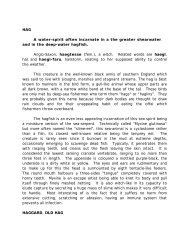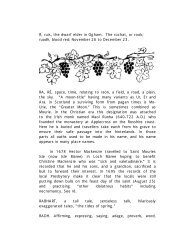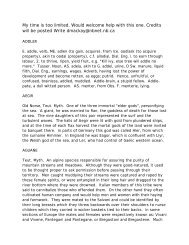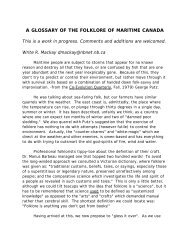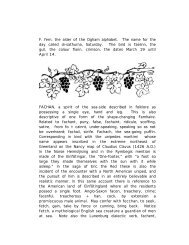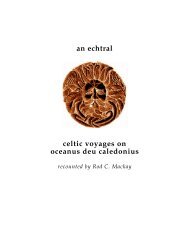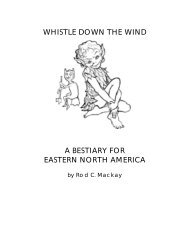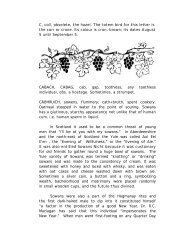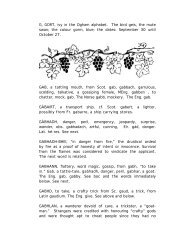L, luis, the mountain ash in the Ogham. Confers ... - Rodney Mackay
L, luis, the mountain ash in the Ogham. Confers ... - Rodney Mackay
L, luis, the mountain ash in the Ogham. Confers ... - Rodney Mackay
You also want an ePaper? Increase the reach of your titles
YUMPU automatically turns print PDFs into web optimized ePapers that Google loves.
with<strong>in</strong> your bone-marrow?"<br />
LOISNEACH, cunn<strong>in</strong>g, “foxy,” Ir. loise, a fox, OHG. luhs, AS,<br />
lox, Eng. lynx.<br />
LON, a demon, a blackbird, .lon-chraois, gluttony (of a<br />
demon). Lonach, greedy, The root is leuq, light, and has<br />
reference to <strong>the</strong> Gaelic sun-god Lugh and to <strong>the</strong> Norse Lokki.<br />
Note also lon, prattle, forwardness, <strong>the</strong> Ir. lonaigh, a jest.<br />
One of this species came to Fionn and Caoilte: He was<br />
obviously a famhair s<strong>in</strong>ce he was described as “a young<br />
man, very big and very ugly, hav<strong>in</strong>g but one eye and one hand,<br />
and wear<strong>in</strong>g a cloak of black sk<strong>in</strong>s over his shoulder. In his<br />
hand was a blunt ploughshare and it was red (like Thor’s<br />
hammer). And he told <strong>the</strong>m he was one of <strong>the</strong> three smiths<br />
of <strong>the</strong> K<strong>in</strong>g of Lochlann (<strong>the</strong> O<strong>the</strong>rworld). And whe<strong>the</strong>r he<br />
hoped to lead <strong>the</strong>se men, or run from <strong>the</strong>m, he started away,<br />
and <strong>the</strong>y followed across all Ireland to Slieve-na-Righ and<br />
to Luimneach and to Ath Lua<strong>in</strong> and on past Cruachan to Ess<br />
Ruadh and Be<strong>in</strong>n Edair and so to <strong>the</strong> sea. And <strong>the</strong>re<br />
(presumably with<strong>in</strong> <strong>the</strong> ocean) <strong>the</strong>y found a smithy, and<br />
went <strong>in</strong>to it, and found four giants at work, and each of<br />
<strong>the</strong>m had seven heads. Fionn and Caoilte had <strong>the</strong>m f<strong>ash</strong>ion<br />
swords, and made good use of <strong>the</strong>m afterwards. And here<br />
two was f<strong>ash</strong>ioned Mac an Lu<strong>in</strong> and Fionn’s shield which he<br />
called Sgiath Gailbh<strong>in</strong>n, <strong>the</strong> Storm Shield, and when it<br />
called out for his danger it could be heard all over Ireland.”<br />
LON-CHRAOIS, gluttony, MIr, lon-crais, sometimes given as<br />
lon, water + craos, <strong>the</strong> wide opened mouth, a water-demon.<br />
Note also crosean,m a buffoon or quarter-day fool, <strong>the</strong> Lat.<br />
crapula, <strong>the</strong> source of <strong>the</strong> Eng. Crap and Crapper.<br />
Additionally lon may be <strong>in</strong>terpreted as prattle or<br />
foolishness and relates to luach, <strong>ash</strong>es. Note lon-aighear,<br />
boisterous mirth.<br />
LONG, an ocean-go<strong>in</strong>g ship, Cym. llong, ON. lung; cf. Lat.<br />
lagena, a long-stemmed flagon. Sometimes supposed<br />
borrowed from Lat. longa, <strong>the</strong> name given <strong>the</strong>ir war-ship,



